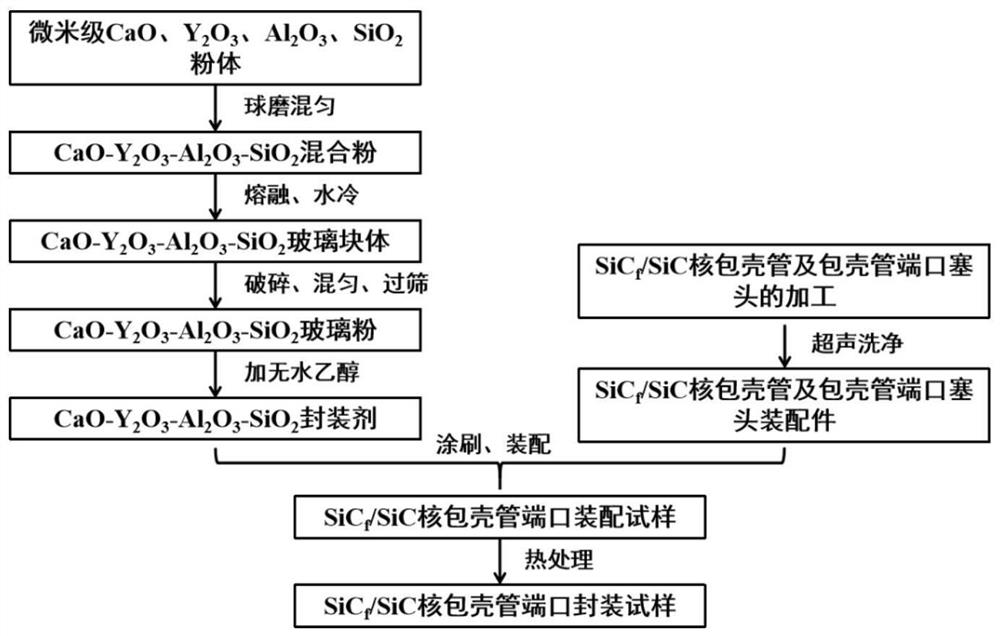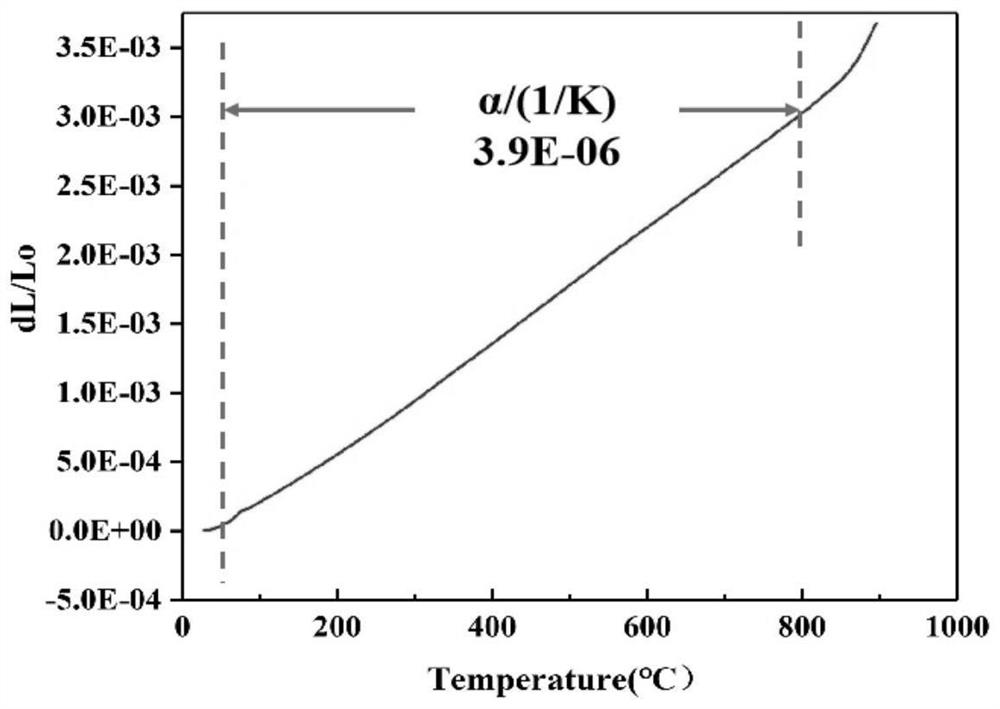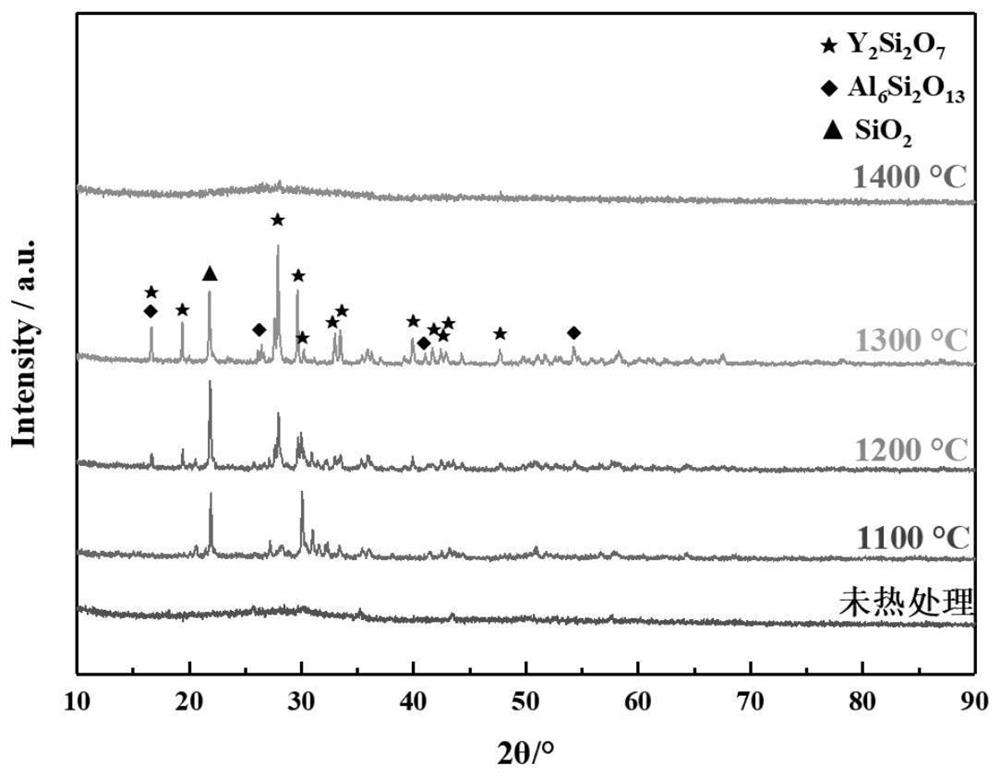sic f /sic nuclear cladding tube port cao-y 2 o 3 -al 2 o 3 -sio 2 Glass encapsulation method
A glass encapsulation and cladding tube technology, used in nuclear power generation, reduction of greenhouse gases, fuel elements, etc., can solve problems such as loss of mechanical properties, exposed core, hydrogen explosion, etc., to ensure the stability of microstructure and nuclear radiation decay. Small rate, small effect of nuclear radiation decay
- Summary
- Abstract
- Description
- Claims
- Application Information
AI Technical Summary
Problems solved by technology
Method used
Image
Examples
Embodiment 1
[0049] Use CaO and Y with a particle size of ~1μm 2 o 3 、Al 2 o 3 , SiO 2 Powder, its mass ratio is: 9.0% CaO, 18.2% Y 2 o 3 , 27.3% Al 2 o 3 , 45.5% SiO 2 , Put the four kinds of powders into the ball milling pot and mill them at a speed of 300r / min for 12 hours, put the mixed powders after ball milling in an alumina crucible, and carry out heat treatment in an air atmosphere. The heat treatment temperature is 1650°C, and the holding time is 2 Hours, after heat treatment, place it directly in cold water for rapid cooling to form a CYAS glass block. The glass block is crushed and ball-milled, and sieved through a 150-mesh sieve to obtain CYAS glass powder. Alcohol is added to the glass powder to form an encapsulating agent, and the mass fraction of the added alcohol is 90%. Coat the encapsulant on the inner wall of the cladding tube and the surface of the cladding tube plug to be sealed, press the glass powder into a sheet with a thickness of 3mm and place it on the ...
Embodiment 2
[0051] Use CaO and Y with a particle size of ~1μm 2 o 3 、Al 2 o 3 , SiO 2 Powder, its mass ratio is: 4.8% CaO, 19.0% Y 2 o 3 , 28.6% Al 2 o 3 , 47.6% SiO 2 , Put the four kinds of powders into the ball milling pot and mill them at a speed of 300r / min for 12 hours, put the mixed powders after ball milling in an alumina crucible, and conduct heat treatment in an air atmosphere. The heat treatment temperature is 1600°C, and the holding time is 2 Hours, after heat treatment, place it directly in cold water for rapid cooling to form a CYAS glass block. The glass block is crushed and ball-milled, and sieved through a 150-mesh sieve to obtain CYAS glass powder. Alcohol is added to the glass powder to form an encapsulating agent, and the mass fraction of the added alcohol is 70%. Coat the encapsulant on the inner wall of the cladding tube and the surface of the cladding tube plug to be sealed, press the glass powder into a sheet with a thickness of 3mm and place it on the cl...
Embodiment 3
[0053] Use CaO and Y with a particle size of ~1μm 2 o 3 、Al 2 o 3 , SiO 2 Powder, its proportioning mass ratio is: 20% Y 2 o 3 , 30% Al 2 o 3 , 50% SiO 2 , Put the four kinds of powders into the ball milling tank and mill them at a speed of 300r / min for 12 hours, put the mixed powders after ball milling in an alumina crucible, and perform heat treatment in an air atmosphere. The heat treatment temperature is 1650°C, and the holding time is 3 Hours, after heat treatment, place it directly in cold water for rapid cooling to form a YAS glass block. The glass blocks are crushed and ball-milled, and sieved through a 150-mesh sieve to obtain YAS glass powder. Alcohol is added to the glass powder to form an encapsulating agent, and the mass fraction of the added alcohol is 70%. Coat the encapsulant on the inner wall of the cladding tube and the surface of the cladding tube plug to be sealed, press the glass powder into a sheet with a thickness of 3mm and place it on the cla...
PUM
| Property | Measurement | Unit |
|---|---|---|
| particle size | aaaaa | aaaaa |
| diameter | aaaaa | aaaaa |
| thickness | aaaaa | aaaaa |
Abstract
Description
Claims
Application Information
 Login to View More
Login to View More - R&D
- Intellectual Property
- Life Sciences
- Materials
- Tech Scout
- Unparalleled Data Quality
- Higher Quality Content
- 60% Fewer Hallucinations
Browse by: Latest US Patents, China's latest patents, Technical Efficacy Thesaurus, Application Domain, Technology Topic, Popular Technical Reports.
© 2025 PatSnap. All rights reserved.Legal|Privacy policy|Modern Slavery Act Transparency Statement|Sitemap|About US| Contact US: help@patsnap.com



